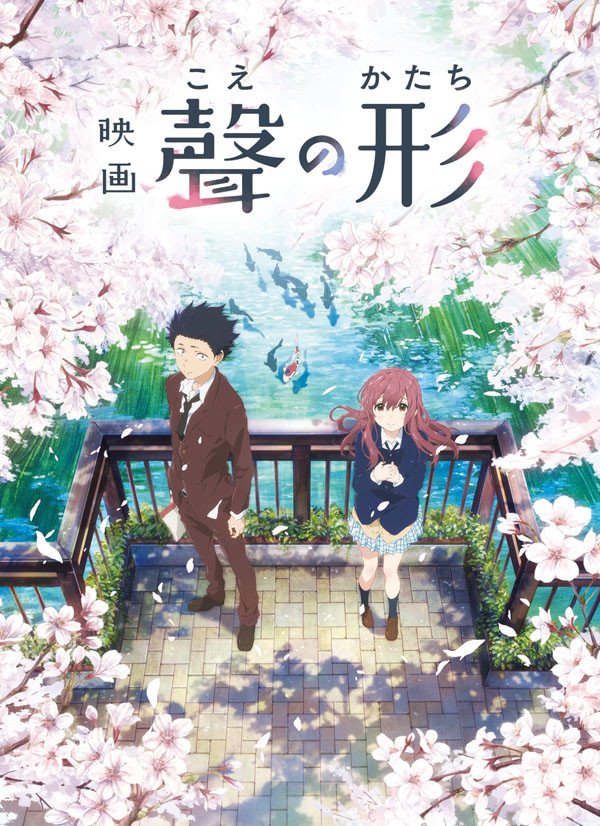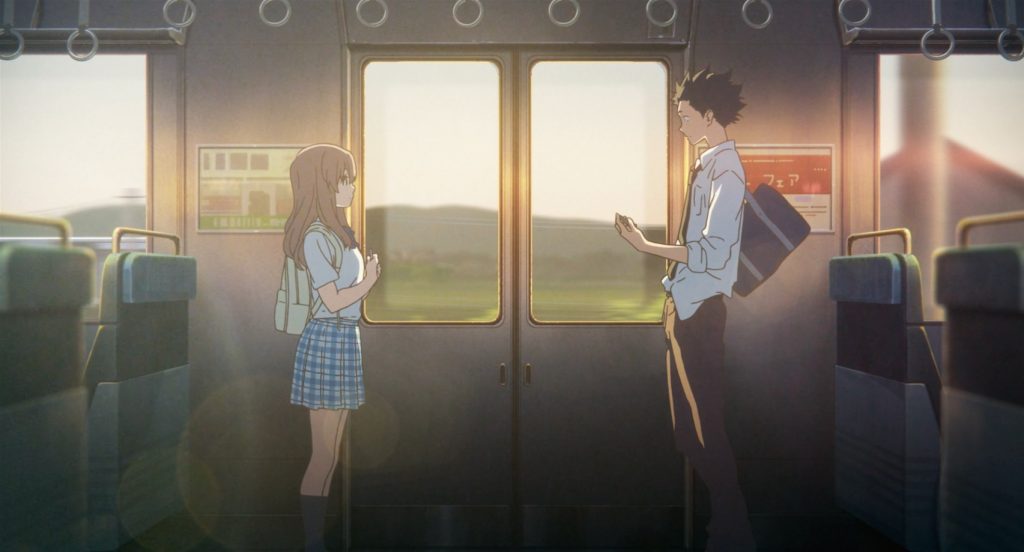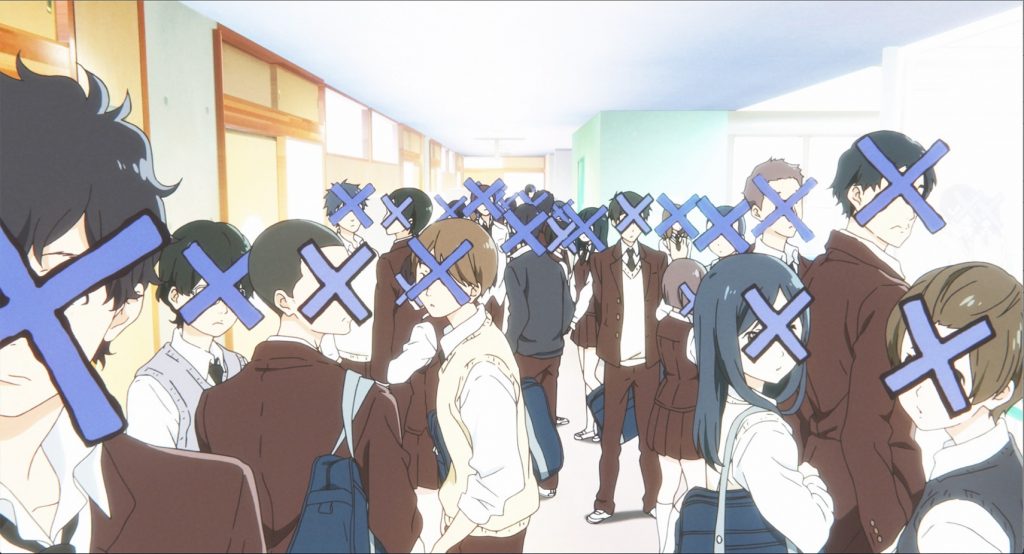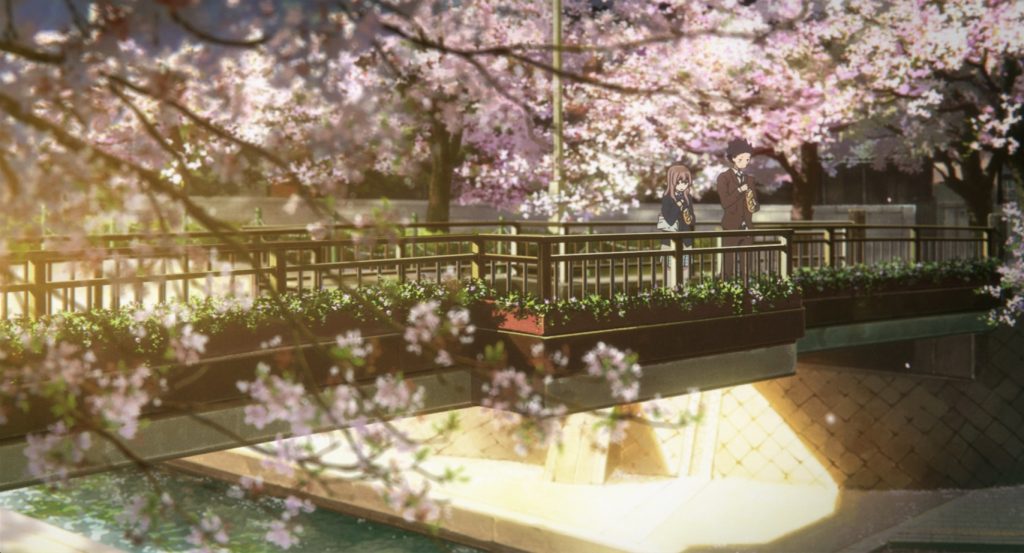Film Review: A Silent Voice

Shoya Ishida is a typical delinquent elementary school boy with a large group of friends and not a care in the world, that is until a new student– Shoko Nishimiya, who happens to be deaf – joins his class. Despite her shy and friendly nature, her presence stirs Shoya’s small world and he begins to bully her, with encouragement from his friends. When the bullying reaches its peak, and he is punished severely for it, his friends disown him and he becomes an outcast himself. Several years later, now in High School, Shoya crosses paths with Nishimiya once again and he slowly begins to reconnect with her, as well as make amends for his past actions.
The role of ‘the school bully’ is normally reserved for antagonists or side characters where they, for the most part, remain one-dimensional (mean for the sake of being mean). If they do have an arc, it’s almost always them getting called out on their behaviour usually by the protagonists, then they quickly reform from their bullying ways and the world is set to rights. However, A Silent Voice makes a bold move in making the bully the protagonist, and there’s no doubt that he is a bully; it starts off with childish lashing out at something (or in this case, someone) that he does not understand but escalates into outright horrible behaviour that makes it incredibly hard to watch. But then his world comes crashing down; he gets told off by the teachers, his friends and the rest of the school completely turn on him AND his mother has to pay a huge fine for Nishimiya’s damaged hearing aids. In a lesser movie, or a movie not set around Shoya, that would be the end of his arc, the audience would assume that he has learned his lesson and that the balance is now restored. But A Silent Voice dares to explore his character further: what happens after he’s punished for his actions? What becomes of his home life and mental state? The answer is that over the years of being exiled and living with the crushing guilt of his actions, he has become incredibly depressed, suffering from anxiety, and is suicidal. It would be easy to brush off Shoya’s plight and emotional state as ‘karma’: he deserved what he got. But A Silent Voice does not set out to do that, or attempt to take the easy route; it instead lays the groundwork and then sets off on a journey for an incredibly involving and significant film.

A Silent Voice talks about a lot of issues that many films either gloss over, sensationalise or wouldn’t touch with a 10-foot pole. This list includes but is not limited to depression, anxiety, loneliness, suicide, self-hatred and learning to forgive yourself. A person suffering from any of these things in media such as television would typically have it communicated to audience via actively saying what they feel or suffer from, looking miserable all the time, or having a cut-away of them taking pills (shorthand for medicating whatever they’re suffering from). A Silent Voice doesn’t do any of this, but takes a more realistic and natural approach; Shoya’s depression and self-deprecation is not limited to being expressed via dialogue but also in his body language and animation techniques. Whether he’s speaking or not, we see him constantly having his head down, struggling to make eye contact with other students, being apprehensive of taking actions if it involves other people and in one scene he even slaps himself as self-punishment for saying something embarrassing. Over the course of the film we discover that it’s not just Shoya who has problems but also other members of the student body, especially Shoko Nishimiya, whom we learn deals with her life-long struggle of deafness and the stigma that comes with it by putting on a friendly but aloof front, and in turn speaks very little about how she actually feels, which is just as damaging as the way Shoya goes about it. Then there are the other side characters who have reacted or thought differently about what happened in elementary school, whether it’s via denial or choosing to move on, and so forth. The side characters don’t get the same amount of attention as Shoya or Nishimiya but how they all interact with each other, and discuss or choose to ignore the issues hovering over them all adds layers to the important themes shown in the movie. There’s no one way to cope or live with these issues, and as the movie shows different sides of them, and uncovers what creates them – or how they remain if not treated – the results are both heart-warming and heart-breaking.
In turn, the animation allows the audience to see exclusively through Shoya’s point of view by having all the students’ faces covered up with a cross; a reflection of how he sees them all as people he cannot communicate with or reach out to. It’s over the course of the film, as he begins to work through his problems, that the crosses start to come off, but like a reflection of real life where we have setback days, the crosses are sometimes slapped back on as Shoya retreats once more into his shell. There’s also a variety of other techniques: blurry images, flares, water ripples/reflections and, right at the beginning of the movie, we see a long dark tunnel with an incoherent image at the end which comes full circle in the final scenes of the film. Although a lot of these images are eventually explained and make sense over the course of the story, when they are first introduced, they’re hastily thrown in back-to-back and therefore it feels a bit of a mess. Imagery and symbolism is important and should absolutely be used but for the first half of this movie they play out more like ‘ideas the director thought up and wanted to throw in there’ rather than strategically placed elements. Even the ‘cross over the faces’ trick, which is the strongest and most frequently used animation metaphor, only comes into play about 20 minutes into the film.

If you only looked at the trailers and did minimal research before seeing the movie, you could have easily been fooled into thinking that it’s a high school romance story with the unique selling point being that it involves a deaf girl. Whilst the ‘deaf girl’ angle is definitely interesting and a hook into the movie by itself, Shoko Nishimiya’s condition is more than just a gimmick. She expresses a lot of her personality in the way she moves, smiling at others despite what they are saying about her and in the way she tries to communicate with everyone despite her limitations. What’s also charming is that she’s not portrayed as a martyr, someone that everyone needs to love and she doesn’t have (for instance) super awesome intellect or heightened senses that have come about as a result of being deaf; she’s a normal high school girl with flaws like everyone else and a lot of emotional baggage, that in a way mirrors Shoya’s struggles but she chooses to bury it as her way of coping. The time-skip also serves as an important point in her character arc as well; her being deaf and a victim of said bullying absolutely would warrant such intricate dejected feelings, but having the bullying issues resolved by the time she enters high school doesn’t mean that the mental trauma suddenly no longer exists, or that they make up solely who she is as a person. Also, having a boyfriend or your bully coming back as a better person, wanting to make it all better doesn’t make the world suddenly a better place. Real life is more complicated than that; just like having Shoya being punished for his actions doesn’t make it OK that he grows up into a suicidal wreck of a boy, or Nishimiya choosing to forgive and befriend him makes her accountable for any emotional turmoil that happens to her later on in the movie. Nothing is black and white, there are all shades of grey, especially when it comes to the issues this movie chooses to talk about.
The pacing of the film is an odd one, especially since it plays out like a romance/coming-of-age story for the majority of its run time, so when it comes to the big emotional moment between Shoya and Nishimiya you expect the film to wrap up quickly afterwards. However, it continues on for a while but not because it has to resolve multiple plot points like, say, in Your Name. It’s important to note that it’s Shoya Ishida story, it’s his emotional arc, and the problems he has don’t automatically fix themselves in a single moment. Problems such as his, as many of those who have or are suffering from depression will know, are a constant battle and sometimes there are good and bad days. So even though the final scene of the movie feels (as a movie watcher) as if it takes ages to come after the big high, it’s an important moment for the character and wraps up the core themes very nicely.
Kyoto Animation, who produced the visuals for A Silent Voice, have a ton of experience with romance-themed and especially high-school-based stories with series such as Clannad, Air and K-ON! under their belts (the K-ON! series and movie being the series that director Naoko Yamada is best known for). As mentioned earlier, they use a lot of little techniques to get Shoya’s world across to the audience but outside of that, there’s much to admire, from the bright colours and the fluid animation, to the way the school environment is drawn to look familiar, yet different. It avoids the usual pitfalls of the main cast’s desks being on the window side of the classroom, or each room in the school looking exactly the same as the previous one. It’s a well thought out and drawn environment that the story is set in with beautiful imagery for the passing seasons.
Kensuke Ushio, the score composer, doesn’t have many credits aside from Space Dandy but his minimal yet emotional score complements the tender and sensitive nature of the film’s themes. Aiko provides the ending theme ‘Koi wo Shita no wa’ which is sadly rather standard fare but musically it flows from Ushio’s work nicely. However, the movie’s opening is edited to The Who’s ‘My Generation’, which sticks out like a sore thumb against the rest of the score. Lyrically, however, it adds a whole new level of negative connotations to the song, considering that it plays over a montage of young and naive Shoyo hanging out with his friends before the events of the movie properly kick off.

A Silent Voice is an emotionally important coming-of-age tale, it tackles a lot of themes that will resonate with audiences on numerous levels with its deep, delicate examination of uncomfortable but significant feelings without falling back on familiar tropes to gain an easy ending. It’s a beautiful, thought-provoking film that shouldn’t be missed.

